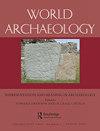日本西南部琉球群岛旧石器时代航海的综合模型
IF 1.8
2区 历史学
0 ARCHAEOLOGY
引用次数: 3
摘要
水运技术的兴起使早期现代人类能够将其可居住的领土扩展到岛屿环境。然而,除了对Wallacea的深入讨论外,旧石器时代航海的发展过程和区域差异仍不清楚。为了解决这个问题,作者提出了一个西太平洋另一个地区——琉球群岛(Ryukyus)旧石器时代航海的综合模型。在这里,一些岛屿远在100多公里之外,在地平线上看不见,世界上最强的洋流之一干涉了海道。尽管面临这些挑战,旧石器时代的遗址仍然出现在大约35,000-30,000年前的1200公里岛链的大部分地区。通过整合目前从考古学、骨骼形态学、遗传学、古地理学、海洋学和我们自己的实验航行项目中获得的信息,作者讨论了可能的迁徙路线、可能的船只、成功的海上迁徙所需的准备和策略,以及与深入了解人类海洋活动的起源和发展有关的其他问题。本文章由计算机程序翻译,如有差异,请以英文原文为准。
A synthetic model of Palaeolithic seafaring in the Ryukyu Islands, southwestern Japan
ABSTRACT The rise of water transport technology enabled early modern humans to expand their habitable territory to insular environments. However, apart from intensive discussion for Wallacea, developmental process and regional variation of Palaeolithic seafaring remain unclear. To contribute this issue, the author presents a synthetic model for Palaeolithic seafaring in another region of the western Pacific, the Ryukyu Islands (Ryukyus). Here, some islands were more than 100 km away and invisible beyond the horizon, and one of the world’s strongest ocean currents intervened the seaways. Despite these challenging situations, Palaeolithic sites appeared throughout much of the 1,200 km chain of the islands ~35,000–30,000 years ago. By integrating currently available information from archaeology, skeletal morphology, genetics, palaeogeography, oceanography and our own experimental voyage project, the author discusses probable migration routes, possible watercrafts, preparation and strategy needed for successful maritime migrations, and other issues relevant to deeper understanding of the origins and development of human maritime activities.
求助全文
通过发布文献求助,成功后即可免费获取论文全文。
去求助
来源期刊

WORLD ARCHAEOLOGY
ARCHAEOLOGY-
CiteScore
2.60
自引率
0.00%
发文量
32
期刊介绍:
World Archaeology was established specifically to deal with archaeology on a world-wide multiperiod basis. Thirty years after it was founded it remains a leader in its field. The first three of the year"s quarterly issues are each dedicated to a particular theme of current interest. The fourth issue, Debates in World Archaeology, is a forum for debate, discussion and comment. All papers adopt a broad comparative approach, looking at important issues on a global scale. The members of the editorial board and the advisory board represent a wide range of interests and expertise and this ensures that the papers published in World Archaeology cover a wide variety of subject areas.
 求助内容:
求助内容: 应助结果提醒方式:
应助结果提醒方式:


